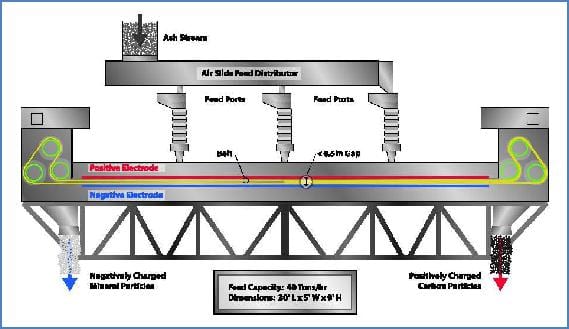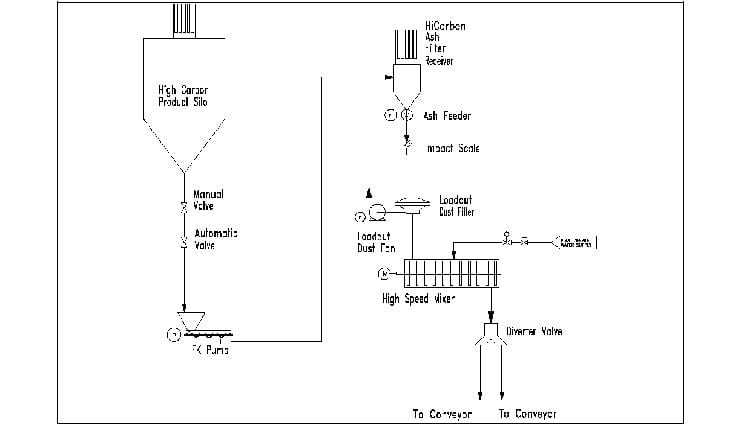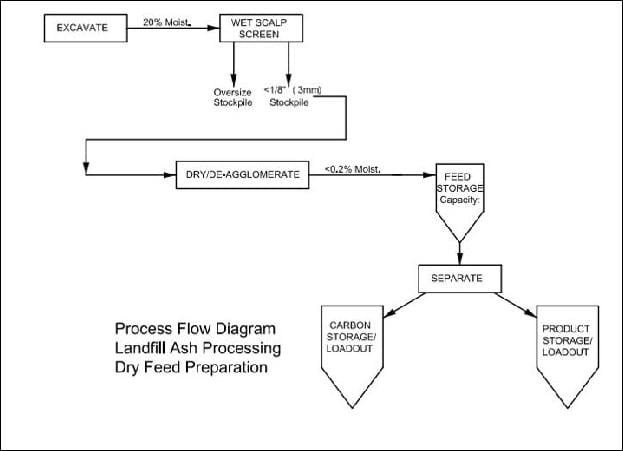Seleccioneu idioma:
Triboelectrostatic separation has been used for the commercial beneficiation of coal combustion fly ash to produce a low carbon product for use as a cement replacement in concrete for nearly twenty years…. STET’s patented electrostatic separator has been used to produce over 15 Million tonnes of low carbon product…Recent environmental legislation…coupled with a requirement …to empty historical landfill sites, has created the need to develop a process to beneficiate historically landfilled ash…
Descarregar PDFTriboelectrostatic Beneficiation of
Land Filled Fly Ash
L. Forner, A. Gupta, i S. Gasiorowski
ST equips & Tecnologies LLC, 101 Hampton avinguda, Needham MA 02494 EUA
CONFERENCE: 2015 Món de cendra de carbó- (www.worldofcoalash.org)
PARAULES CLAU: Triboelectrostatic, Beneficiation, Cendra volant, Landfilled, Dried, Separació, Carboni
ABSTRACT
Triboelectrostatic separation has been used for the commercial beneficiation of coal combustion fly ash to produce a low carbon product for use as a cement replacement in concrete for nearly twenty years. With 18 separators in 12 coal-fired power plants across the world, ST equips & Tecnologia LLC (STET) patented electrostatic separator has been used to produce over 15 Million tonnes of low carbon product.
To date, commercial beneficiation of fly ash has been performed exclusively on dry “run of station‿ ash. Recent environmental legislation has created, in certain markets, a need to supply beneficiated ash in times of low ash generation. Això, coupled with a requirement in some locations to empty historical ash landfill sites, has created the need to develop a process to beneficiate historically landfilled ash.
Previous studies have shown that the exposure of fly ash to moisture, and subsequent drying influences the triboelectrostatic charging mechanism, with carbon and mineral particles charging in the opposite polarity to that experienced with run of station ash. Studies have been performed by the authors to determine the effect of moisture exposure on separation efficiency of several ashes that have been reclaimed from landfills and dried. Charge reversal was experienced following drying, però en general l'eficiència de separació va ser aconseguit equivalent a l'experimentada amb cursa fresc de cendra de l'estació.
Va examinar l'efecte de cendra assecada menjar humitat relativa a l'eficiència de separació de triboelectrostatic, i sensibilitat era molt reduït en comparació amb allò experimentat amb la cursa de l'estació de cendra, reducció procés en general costos.
INTRODUCCIÓ
L'Associació Americana de carbó cendra (ACAA) enquesta anual de producció i ús de cendres de carbó que entre els informes 1966 i 2011, sobre 2.3 billion short tons of fly ash have been produced by coal-fired utility boilers.1 D'aquesta quantitat aproximadament 625 milions de tones s'han utilitzat junts, principalment per a la producció de ciment i formigó. No obstant això, the remaining 1.7+ billion tons are primarily found in landfills or filled ponded
impoundments. While utilization rates for freshly generated fly ash have increased considerably over recent years, with current rates near 45%, aproximadament 40 million tons of fly ash continue to be disposed of annually. While utilization rates in Europe have been much higher than in the US, considerable volumes of fly ash have also been stored in landfills and impoundments in some European countries.
Últimament, interest in recovering this disposed material has increased, partially due to the demand for high-quality fly ash for concrete and cement production during a period of reduced production as coal-fired power generation has decreased in Europe and North America. Concerns about the long-term environmental impact of such landfills are also prompting utilities to find beneficial use applications for this stored ash.
LAND FILLED ASH QUALITY AND REQUIRED BENEFICIATION
Mentre que alguns d'aquest emmagatzema cendra volant pot ser adequat per a ús com inicialment excavat, la gran majoria serà necessari algun tractament per satisfer els estàndards de qualitat per a ciment o formigó. Ja que el material ha estat típicament wetted per permetre la manipulació i compactació, evitant la generació de pols en l'aire, assecat probablement serà un requisit mínim per a ús en concret ja productors formigó haurà de continuar la pràctica de cendra volant com un pols seca de formigó. No obstant això, assuring the chemical composition of the ash meets specifications, most notably the carbon content measured as loss-on-ignition (LOI), is a greater challenge. As fly ash utilization has increased in the last 20+ anys, most “in-spec‿ ash has been beneficially used, and the off-quality ash disposed. Thus, LOI reduction will be a requirement for utilizing the vast majority of fly ash recoverable from utility impoundments.
LOI REDUCTION BY TRIBOELECTRIC SEPARATION
While various workers have used combustion techniques and flotation processes for LOI reduction of recovered landfilled and ponded fly ash, ST equips & Technologies (STET) has found that its standard processing system, long used for beneficiation of freshly generated fly ash, is equally effective on recovered ash after suitable drying and deagglomeration at lower overall operating costs.
During the ramp-up to commercial application of the STET processing system for fly ash, STET researchers tested the separation of dried landfilled ash. This recovered ash separated very similarly to freshly generated ash with one surprising difference: the particle charging was reversed from that of fresh ash with the carbon charging negative in relation to the mineral.2 Other researchers of electrostatic separation of fly ash carbon have also observed this phenomena.3,4,5

TECHNOLOGY OVERVIEW – FLY ASH CARBON SEPARATION
In the STET carbon separator (Figura 1), material is fed into the thin gap between two parallel planar electrodes. Les partícules triboelectrically paguen per contacte interparticle. The positively charged carbon and the negatively charged mineral (in freshly generated ash that has not been wetted and dried) són atrets a davant elèctrodes. The particles are then swept up by a continuous moving belt and conveyed in opposite directions. El cinturó mou les partícules adjacents a cada elèctrode cap a extrems oposats del separador. L'alta velocitat del cinturó també permet rendiments molt alts, fins a 36 tones per hora en un únic separador. Del buit, high voltage field, counter current flow, vigorous particle-particle agitation and self-cleaning action of the belt on the electrodes are the critical features of the STET separator. Controlant diversos paràmetres del procés, Com la velocitat del cinturó, punt d'alimentació, i la taxa d'alimentació, el procés STET produeix cendres de mosca LOI baixes a un contingut de carboni inferior a 1.5 a 4.5% from feed fly ashes ranging in LOI from 4% per sobre 25%.
Figa. 1 STET Separator
El disseny de separador és relativament senzilla i la compacta. Una màquina destinada a processar 36 tones per hora és aproximadament 9 m (30 peus.) llarg, 1.5 m (5 peus.) àmplia, i 2.75 m (9 peus.) alta. El cinturó i rodets associats són les úniques parts en moviment. Els elèctrodes són estacionaris i formada per un material durable adequadament. La cinta està fet de no- plàstic conductiu. Tracta de consum d'energia del separador 1 quilowatts-hora per tona de material processat amb la major part de la potència consumida per dos motors que condueixen el cinturó.
El procés és totalment sec, requereix cap material addicional que no sigui la cendra volant i produeix sense residus emissions aigua o aire. The recovered materials consist of fly ash reduced in carbon content to levels suitable for use as a pozzolanic admixture in
formigó, and a high carbon fraction useful as fuel. La utilització d'ambdós fluxos de productes proporciona un 100% Solució als problemes d'eliminació de cendres volants.
RECOVERED FUEL VALUE OF HIGH-CARBON FLY ASH
In addition to the low carbon product for use in concrete, brand named ProAsh®, the STET separation process also recovers otherwise wasted unburned carbon in the form of carbon-rich fly ash, branded EcoTherm™. EcoTherm™ té valor significatiu de combustible i fàcilment pot tornar a la planta d'energia elèctrica utilitzant l'STET EcoTherm™ Sistema de devolució per reduir l'ús de carbó a la planta. Quan EcoTherm™ es crema a la caldera d'utilitat, l'energia de combustió és convertida a alta pressió / vapor a alta temperatura i després a l'electricitat a la mateixa eficàcia que carbó, típicament 35%. The conversion of the recovered thermal energy to electricity in ST Equipment & Technology LLC EcoTherm™ Return system is two to three times higher than that of the competitive technology where the energy is recovered as low-grade heat in the form of hot water which is circulated to the boiler feed water system. EcoTherm™ is also used as a source of alumina in cement kilns, displacing the more expensive bauxite which is usually transported long distances. Utilizing the high carbon EcoTherm™ ash either at a power plant or a cement kiln, maximizes the energy recovery from the delivered coal, reducing the need to mine and transport additional fuel to the facilities.
STET’s Raven Power Brandon Shores, SMEPA R.D. Demà, NBP Belledune, RWEnpower Didcot, EDF Energy West Burton, and RWEnpower Aberthaw fly ash plants, all include EcoTherm™ Return systems. The essential components of the system are presented in Figure 2.

Figa. 2 EcoTherm™ Return system
STET ASH PROCESING FACILITIES
Controlled low LOI fly ash is produced with STET’s technology at twelve power stations throughout the U.S., Canadà, the U.K., Polònia, and Republic of Korea. ProAsh® fly ash has been approved for use by over twenty state highway authorities, Així com moltes altres agències d'especificació. ProAsh® has also been certified under Canadian Standards Association and EN 450:2005 Estàndards de qualitat a Europa. Ash processing facilities using STET technology are listed in Table 1.
Taula 1. STET Commercial Operations
|
Utilitat / Power Station |
Ubicació |
Start of Commercial operations |
Facility Details |
|
Progress Energy – Roxboro Station |
Carolina del Nord Estats Units |
Sept. 1997 |
2 Separadors |
|
Raven Power – Brandon Shores Station |
Maryland Estats Units |
Abril 1999 |
2 Separadors 35,000 ton storage dome. Ecotherm™ Return 2008 |
|
ScotAsh (Lafarge / Scottish Power Joint Venture) – Estació de Longannet |
Escòcia Regne Unit |
Octubre. 2002 |
1 Separador |
|
Jacksonville Electric Authority – St. John’s River Power Park,FL |
Florida Estats Units |
Maig 2003 |
2 Separators Coal/Petcoke blends Ammonia Removal |
|
South Mississippi Electric Power Authority R.D. Morrow Station |
Mississipí Estats Units |
Gener. 2005 |
1 Separator Ecotherm™ Return |
|
New Brunswick Power Company Belledune Station |
New Brunswick, Canadà |
Abril 2005 |
1 Separator Coal/Petcoke Blends Ecotherm™ Return |
|
RWE npower Didcot Station |
Anglaterra Regne Unit |
Agost 2005 |
1 Separator Ecotherm™ Return |
|
PPL Brunner Island Station |
Pennsilvània Estats Units |
Desembre 2006 |
2 Separadors 40,000 Ton storage dome |
|
Tampa Electric Co. Big Bend Station |
Florida Estats Units |
Abril 2008 |
3 Separadors, double pass 25,000 Ton storage dome Ammonia Removal |
|
RWE npower Aberthaw Station (Lafarge Cement UK) |
Gal·les Regne Unit |
Setembre 2008 |
1 Separator Ammonia Removal Ecotherm™ Return |
|
EDF Energy West Burton Station (Lafarge Cement UK, Cemex) |
Anglaterra Regne Unit |
Octubre 2008 |
1 Separator Ecotherm™ Return |
|
ZGP (Lafarge Cement Poland / Ciech Janikosoda JV) |
Polònia |
Març 2010 |
1 Separador |
|
Korea South-East Power Yeongheung Units 5&6 |
Corea del Sud |
Setembre 2014 |
1 Separator Ecotherm™ Return |
COAL ASH RECOVERED FROM LAND FILLS
Two sources of ash were obtained from landfills: sample A from a power plant located in
the United Kingdom and sample B: from the United States. Tant aquestes mostres constava de cendres de la combustió de carbó bituminous per calderes de gran utilitat. A causa de la barreja del material en els abocadors, cap més informació està disponible sobre les condicions d'origen o combustió carbó específics.

Les mostres CNMV STET contenia entre 15% i 20% aigua formades per landfilled material. Les mostres també conté quantitats variables de gran >1/8 polzada (~ 3 mm) material. Per preparar les mostres per a la separació de carboni, the large debris was removed by screening and the samples then dried and deagglomerated prior to carbon beneficiation. Various methods for drying/deagglomeration are being evaluated in order to optimize the overall process. A general process flow sheet is presented in Figure 3.
Figura 3: Process flow sheet
The properties of the prepared samples were well within the range of fly ash obtained directly from normal utility boilers. The most relevant properties for both the separator feeds and products are summarized in Table 2 along with recovered product.
CARBON SEPARATION
Carbon reduction trials using the STET triboelectric belt separator resulted in very good recovery of low LOI product. The interesting phenomena observed was the reversal of charging of the carbon discussed above. While this behavior has been observed previously by STET and other researchers, the mechanism that changes the relative work functions and thus contact charging behavior of the material is not understood. Un va suggerir mecanisme és la redistribució d'ions solubles en el mineral i

partícules de carbó, possiblement més influenciat pel pH de la solució aquosa en la cendra4. Qualsevol que sigui el mecanisme fonamental és, no sembla per degradar l'aplicació pràctica de separació triboelèctric per reduir el contingut de carboni de la cendra.
Les propietats de la baixa cendres LOI recuperat utilitzant el procés STET per tant recollit acabat cendra de la caldera i recuperat de l'abocador de cendres es resumeix en la taula
2.The results show that the STET process efficiency for the recovered landfill ash is within the range expected for ash freshly collected from the utility boiler.
Taula 2: Properties of feed and recovered low-LOI ash.
|
Feed Sample to Separator |
LOI |
ProAsh LOI® |
ProAsh Fineness, %® +45 µm |
ProAsh® Mass Yield |
EcoTherm® High Carbon Product |
|
Fresh A |
10.2 % |
3.6 % |
23 % |
84 % |
39 % |
|
Landfill A |
9.8 % |
3.3 % |
20 % |
75 % |
28 % |
|
Fresh B |
5.3 % |
2.8 % |
17 % |
91 % |
28 % |
|
Landfill B |
6.9 % |
4.5 % |
24 % |
86 % |
26 % |
PROCESS ECONOMICS
In addition to the normal costs of the STET process, the cost of drying the recovered, high moisture content ash will increase the overall operating costs of the process. Taula 3 summarizes the fuel costs for both operations in the USA and UK for 15% i 20% moisture contents. Typical inefficiencies of drying are included in the calculated values. Costs are based on the mass of material after drying.
Taula 3: Drying costs on basis of dried mass.
| Moisture content | Heat Requirement KWhr/t | Drying cost / T dry basis UK | Drying cost / T dry basis US |
|---|---|---|---|
| Gas cost 0.027 £/kWhr | Gas cost $4.75 / mmBtu | ||
| 15 % | 165 | £ 5.24 | £ 1.94 |
| £ 8.48 | £ 3.14 | ||
| £ 6.73 | £ 2.49 | ||
| 20 % | 217 | £ 7.23 | £ 2.71 |
| £ 11.85 | £ 4.39 | ||
| £ 9.40 | £ 3.48 |
ASH CHEMISTRY AND PERFORMANCE IN CONCRETE
The properties of the low carbon ash generated from the dried landfill material were compared to that of freshly obtained ash to check the suitability for use in concrete production. La
following table summarizes the chemistry for samples from source B. Testing on source A material has not been completed.
Taula 4: Ash Chemistry of low LOI ash.
|
Source B material |
SiO2 |
Al2O3 |
Fe2O3 |
CaO |
MgO |
K2O |
Na2O |
SO3 |
|
Fresh Production |
51.60 |
24.70 |
9.9 |
2.22 |
0.85 |
2.19 |
0.28 |
0.09 |
|
Landfilled |
50.40 |
25.00 |
9.3 |
3.04 |
0.85 |
2.41 |
0.21 |
0.11 |
Strength development of a 20% substitution of the low LOI fly ash in a mortar containing 600 lb / yd3 showed the material derived from landfilled ash performed somewhat better than material from fresh production. Veure taula 5 sota.
Taula 5: Compressive strength of mortar cubes.
|
|
7 day Compressive Strength PSI |
28 day Compressive Strength PSI |
|
Fresh |
3948 |
5185 |
|
Landfilled |
4254 |
5855 |
CONCLUSIONS
After suitable scalping of large material, drying, and deagglomeration, fly ash recovered from utility plant landfills can be reduced in carbon content using the commercialized STET triboelectric belt separator. L'eficiència del sistema STET equival essencialment per cendres obtingudes acabat de operacions de caldera i material landfilled seques. El separador producte és apte per a ús en la producció de formigó sense més beneficiation amb propietats gairebé idèntica actuació. The recovery and beneficiation of landfilled ash will provide a continuing supply of high quality ash for concrete producers in spite of the reduced production of “fresh‿ ash as coal-fired utilities reduce generation. A més, power plants that need to remove ash from landfills to meet changing environmental regulations will be able to utilize the process to alter a waste product liability into a valuable raw material for concrete producers.
REFERENCES
[1]American Coal Ash Coal Combustion products and Use Statistics: https://www.acaa-usa.org/Publications/Production-Use-Reports/
[2]ST internal report, Agost 1995.
[3]Li (A prop de,T.X,. Schaefer, J.L., Prohibició, H., Neathery, J.K., and Stencel, J.M. Dry Beneficiation Processing of Combustion Fly Ash, Proceedings of the DOE Conference on Unburned Carbon on Utility Fly Ash, Maig 19 20, Pittsburgh, PA, 1998.
[4]Baltrus, J.P., Diehl, J.R., Soong, I., Sands, W. Triboelectrostatic separation of fly ash and charge reversal, Fuel 81, (2002) pp.757-762.
[5]Cangialosi, F., Notarnicola, M. M., Liberti, L, Stencel, J. The role of weathering on fly ash charge distribution during triboelectrostatic beneficiation, Journal of Hazardous Materials, 164 (2009) pp.683-688.
Word to PDF Converter Converted By BCLTechnologies